Travelodge Marketing Manager Employability Skills Report and Analysis
VerifiedAdded on 2020/01/21
|8
|3821
|38
Report
AI Summary
This report, focused on employability skills, examines the responsibilities and performance objectives of a marketing manager at Travelodge hotel. It evaluates effectiveness, recommends improvements, and explores motivational techniques. The report then delves into problem-solving, specifically addressing employee turnover, and proposes solutions like a new reward system and open communication. Time management strategies and team roles are also discussed, along with an analysis of team dynamics. The report includes a formal letter to senior management and a memo to staff, offering a comprehensive overview of skills essential for professional development in the hospitality industry. This report is a valuable resource for students, providing insights into practical applications of employability skills.
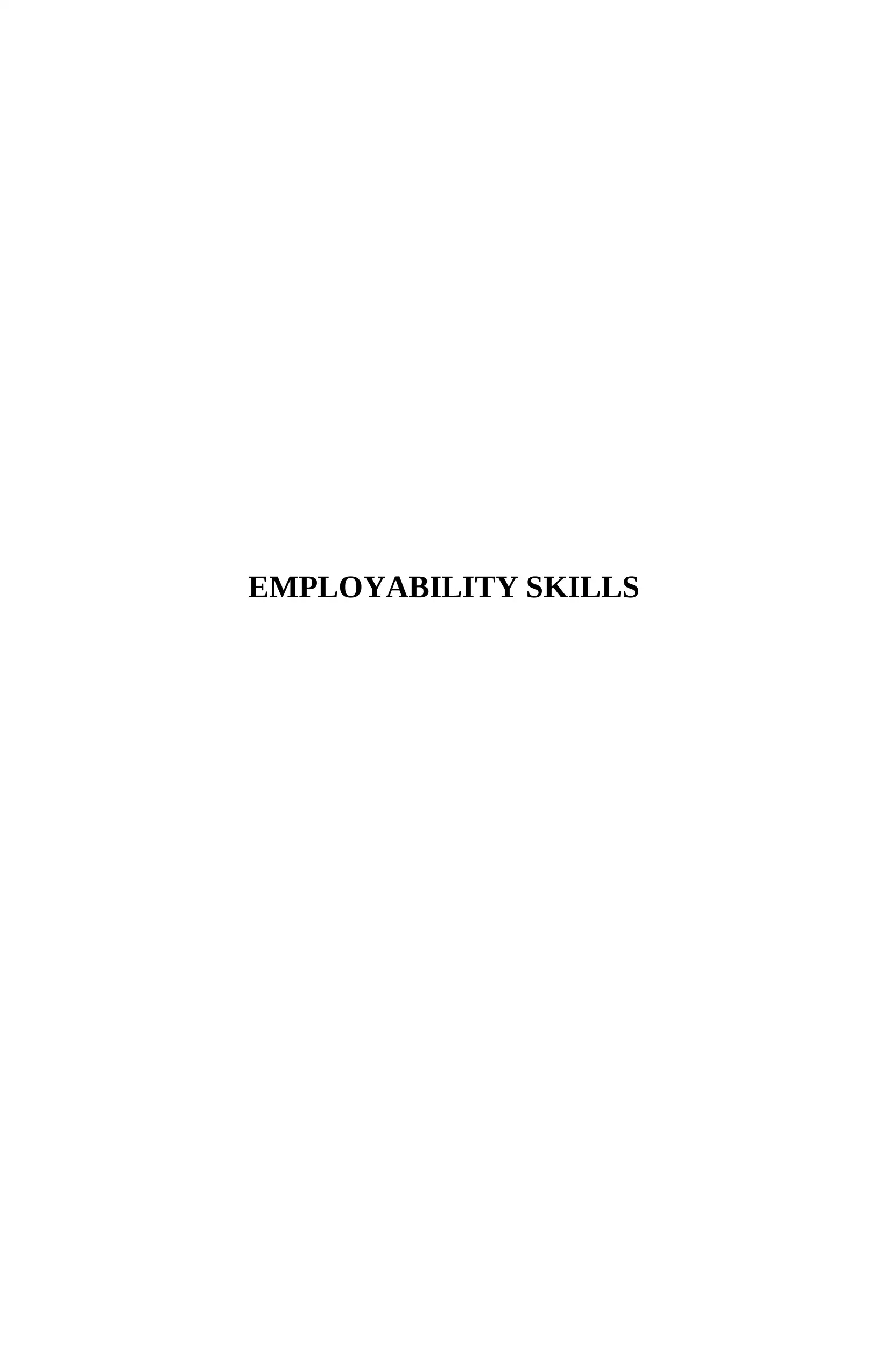
EMPLOYABILITY SKILLS
Paraphrase This Document
Need a fresh take? Get an instant paraphrase of this document with our AI Paraphraser
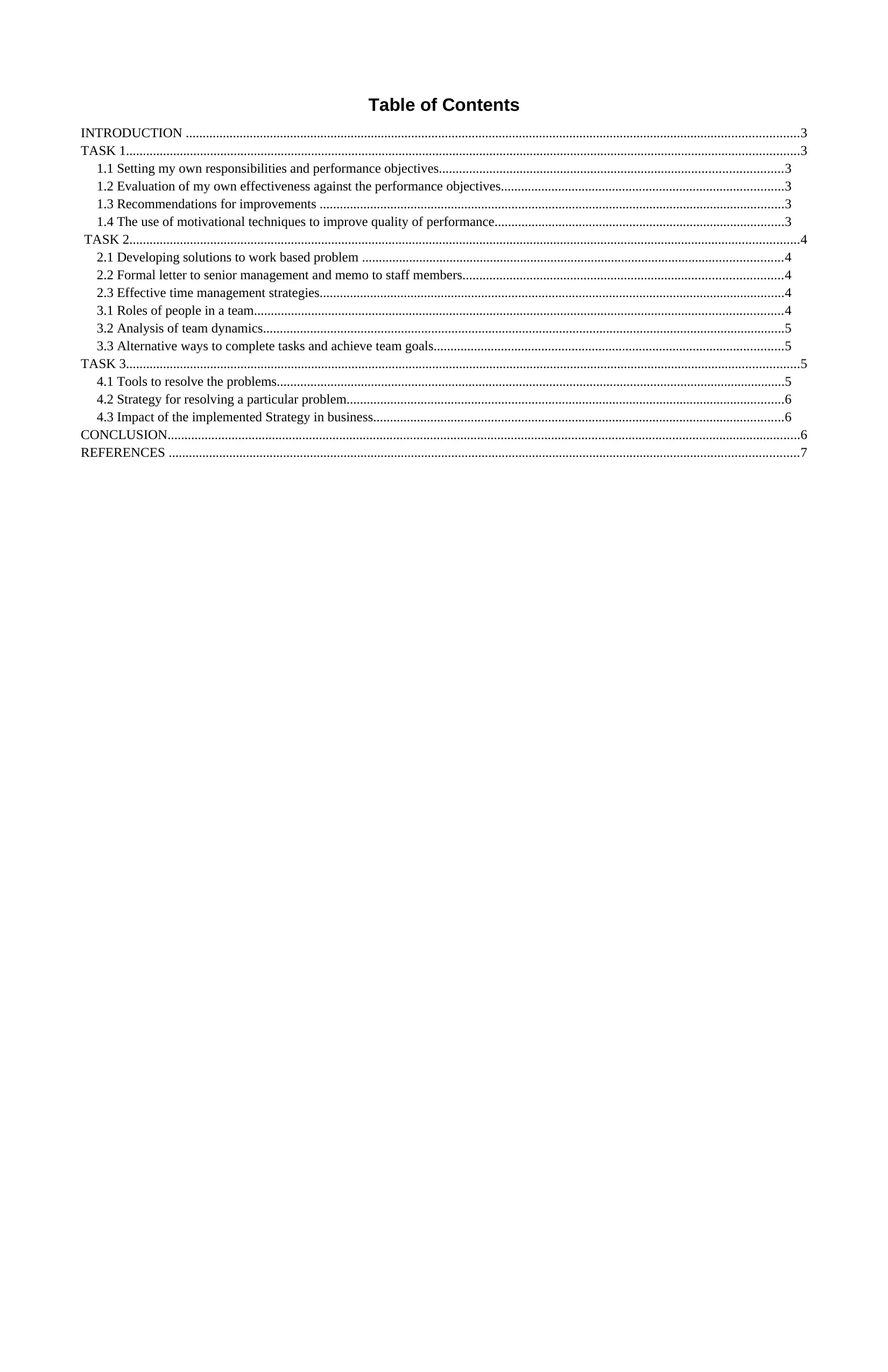
Table of Contents
INTRODUCTION ......................................................................................................................................................................................3
TASK 1........................................................................................................................................................................................................3
1.1 Setting my own responsibilities and performance objectives......................................................................................................3
1.2 Evaluation of my own effectiveness against the performance objectives....................................................................................3
1.3 Recommendations for improvements ..........................................................................................................................................3
1.4 The use of motivational techniques to improve quality of performance......................................................................................3
TASK 2.......................................................................................................................................................................................................4
2.1 Developing solutions to work based problem .............................................................................................................................4
2.2 Formal letter to senior management and memo to staff members...............................................................................................4
2.3 Effective time management strategies..........................................................................................................................................4
3.1 Roles of people in a team.............................................................................................................................................................4
3.2 Analysis of team dynamics...........................................................................................................................................................5
3.3 Alternative ways to complete tasks and achieve team goals........................................................................................................5
TASK 3........................................................................................................................................................................................................5
4.1 Tools to resolve the problems.......................................................................................................................................................5
4.2 Strategy for resolving a particular problem..................................................................................................................................6
4.3 Impact of the implemented Strategy in business..........................................................................................................................6
CONCLUSION............................................................................................................................................................................................6
REFERENCES ...........................................................................................................................................................................................7
INTRODUCTION ......................................................................................................................................................................................3
TASK 1........................................................................................................................................................................................................3
1.1 Setting my own responsibilities and performance objectives......................................................................................................3
1.2 Evaluation of my own effectiveness against the performance objectives....................................................................................3
1.3 Recommendations for improvements ..........................................................................................................................................3
1.4 The use of motivational techniques to improve quality of performance......................................................................................3
TASK 2.......................................................................................................................................................................................................4
2.1 Developing solutions to work based problem .............................................................................................................................4
2.2 Formal letter to senior management and memo to staff members...............................................................................................4
2.3 Effective time management strategies..........................................................................................................................................4
3.1 Roles of people in a team.............................................................................................................................................................4
3.2 Analysis of team dynamics...........................................................................................................................................................5
3.3 Alternative ways to complete tasks and achieve team goals........................................................................................................5
TASK 3........................................................................................................................................................................................................5
4.1 Tools to resolve the problems.......................................................................................................................................................5
4.2 Strategy for resolving a particular problem..................................................................................................................................6
4.3 Impact of the implemented Strategy in business..........................................................................................................................6
CONCLUSION............................................................................................................................................................................................6
REFERENCES ...........................................................................................................................................................................................7
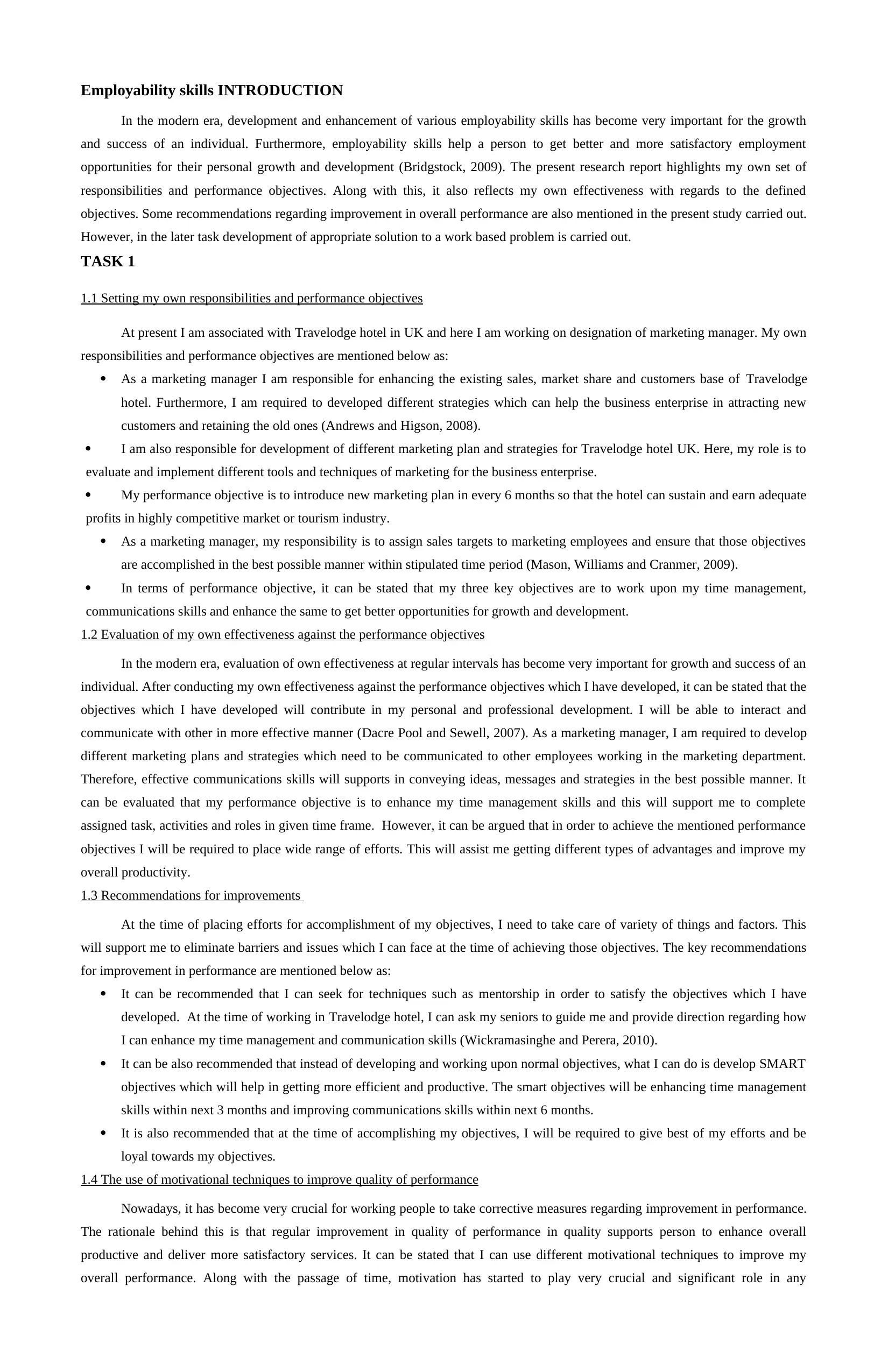
Employability skills INTRODUCTION
In the modern era, development and enhancement of various employability skills has become very important for the growth
and success of an individual. Furthermore, employability skills help a person to get better and more satisfactory employment
opportunities for their personal growth and development (Bridgstock, 2009). The present research report highlights my own set of
responsibilities and performance objectives. Along with this, it also reflects my own effectiveness with regards to the defined
objectives. Some recommendations regarding improvement in overall performance are also mentioned in the present study carried out.
However, in the later task development of appropriate solution to a work based problem is carried out.
TASK 1
1.1 Setting my own responsibilities and performance objectives
At present I am associated with Travelodge hotel in UK and here I am working on designation of marketing manager. My own
responsibilities and performance objectives are mentioned below as:
As a marketing manager I am responsible for enhancing the existing sales, market share and customers base of Travelodge
hotel. Furthermore, I am required to developed different strategies which can help the business enterprise in attracting new
customers and retaining the old ones (Andrews and Higson, 2008).
I am also responsible for development of different marketing plan and strategies for Travelodge hotel UK. Here, my role is to
evaluate and implement different tools and techniques of marketing for the business enterprise.
My performance objective is to introduce new marketing plan in every 6 months so that the hotel can sustain and earn adequate
profits in highly competitive market or tourism industry.
As a marketing manager, my responsibility is to assign sales targets to marketing employees and ensure that those objectives
are accomplished in the best possible manner within stipulated time period (Mason, Williams and Cranmer, 2009).
In terms of performance objective, it can be stated that my three key objectives are to work upon my time management,
communications skills and enhance the same to get better opportunities for growth and development.
1.2 Evaluation of my own effectiveness against the performance objectives
In the modern era, evaluation of own effectiveness at regular intervals has become very important for growth and success of an
individual. After conducting my own effectiveness against the performance objectives which I have developed, it can be stated that the
objectives which I have developed will contribute in my personal and professional development. I will be able to interact and
communicate with other in more effective manner (Dacre Pool and Sewell, 2007). As a marketing manager, I am required to develop
different marketing plans and strategies which need to be communicated to other employees working in the marketing department.
Therefore, effective communications skills will supports in conveying ideas, messages and strategies in the best possible manner. It
can be evaluated that my performance objective is to enhance my time management skills and this will support me to complete
assigned task, activities and roles in given time frame. However, it can be argued that in order to achieve the mentioned performance
objectives I will be required to place wide range of efforts. This will assist me getting different types of advantages and improve my
overall productivity.
1.3 Recommendations for improvements
At the time of placing efforts for accomplishment of my objectives, I need to take care of variety of things and factors. This
will support me to eliminate barriers and issues which I can face at the time of achieving those objectives. The key recommendations
for improvement in performance are mentioned below as:
It can be recommended that I can seek for techniques such as mentorship in order to satisfy the objectives which I have
developed. At the time of working in Travelodge hotel, I can ask my seniors to guide me and provide direction regarding how
I can enhance my time management and communication skills (Wickramasinghe and Perera, 2010).
It can be also recommended that instead of developing and working upon normal objectives, what I can do is develop SMART
objectives which will help in getting more efficient and productive. The smart objectives will be enhancing time management
skills within next 3 months and improving communications skills within next 6 months.
It is also recommended that at the time of accomplishing my objectives, I will be required to give best of my efforts and be
loyal towards my objectives.
1.4 The use of motivational techniques to improve quality of performance
Nowadays, it has become very crucial for working people to take corrective measures regarding improvement in performance.
The rationale behind this is that regular improvement in quality of performance in quality supports person to enhance overall
productive and deliver more satisfactory services. It can be stated that I can use different motivational techniques to improve my
overall performance. Along with the passage of time, motivation has started to play very crucial and significant role in any
In the modern era, development and enhancement of various employability skills has become very important for the growth
and success of an individual. Furthermore, employability skills help a person to get better and more satisfactory employment
opportunities for their personal growth and development (Bridgstock, 2009). The present research report highlights my own set of
responsibilities and performance objectives. Along with this, it also reflects my own effectiveness with regards to the defined
objectives. Some recommendations regarding improvement in overall performance are also mentioned in the present study carried out.
However, in the later task development of appropriate solution to a work based problem is carried out.
TASK 1
1.1 Setting my own responsibilities and performance objectives
At present I am associated with Travelodge hotel in UK and here I am working on designation of marketing manager. My own
responsibilities and performance objectives are mentioned below as:
As a marketing manager I am responsible for enhancing the existing sales, market share and customers base of Travelodge
hotel. Furthermore, I am required to developed different strategies which can help the business enterprise in attracting new
customers and retaining the old ones (Andrews and Higson, 2008).
I am also responsible for development of different marketing plan and strategies for Travelodge hotel UK. Here, my role is to
evaluate and implement different tools and techniques of marketing for the business enterprise.
My performance objective is to introduce new marketing plan in every 6 months so that the hotel can sustain and earn adequate
profits in highly competitive market or tourism industry.
As a marketing manager, my responsibility is to assign sales targets to marketing employees and ensure that those objectives
are accomplished in the best possible manner within stipulated time period (Mason, Williams and Cranmer, 2009).
In terms of performance objective, it can be stated that my three key objectives are to work upon my time management,
communications skills and enhance the same to get better opportunities for growth and development.
1.2 Evaluation of my own effectiveness against the performance objectives
In the modern era, evaluation of own effectiveness at regular intervals has become very important for growth and success of an
individual. After conducting my own effectiveness against the performance objectives which I have developed, it can be stated that the
objectives which I have developed will contribute in my personal and professional development. I will be able to interact and
communicate with other in more effective manner (Dacre Pool and Sewell, 2007). As a marketing manager, I am required to develop
different marketing plans and strategies which need to be communicated to other employees working in the marketing department.
Therefore, effective communications skills will supports in conveying ideas, messages and strategies in the best possible manner. It
can be evaluated that my performance objective is to enhance my time management skills and this will support me to complete
assigned task, activities and roles in given time frame. However, it can be argued that in order to achieve the mentioned performance
objectives I will be required to place wide range of efforts. This will assist me getting different types of advantages and improve my
overall productivity.
1.3 Recommendations for improvements
At the time of placing efforts for accomplishment of my objectives, I need to take care of variety of things and factors. This
will support me to eliminate barriers and issues which I can face at the time of achieving those objectives. The key recommendations
for improvement in performance are mentioned below as:
It can be recommended that I can seek for techniques such as mentorship in order to satisfy the objectives which I have
developed. At the time of working in Travelodge hotel, I can ask my seniors to guide me and provide direction regarding how
I can enhance my time management and communication skills (Wickramasinghe and Perera, 2010).
It can be also recommended that instead of developing and working upon normal objectives, what I can do is develop SMART
objectives which will help in getting more efficient and productive. The smart objectives will be enhancing time management
skills within next 3 months and improving communications skills within next 6 months.
It is also recommended that at the time of accomplishing my objectives, I will be required to give best of my efforts and be
loyal towards my objectives.
1.4 The use of motivational techniques to improve quality of performance
Nowadays, it has become very crucial for working people to take corrective measures regarding improvement in performance.
The rationale behind this is that regular improvement in quality of performance in quality supports person to enhance overall
productive and deliver more satisfactory services. It can be stated that I can use different motivational techniques to improve my
overall performance. Along with the passage of time, motivation has started to play very crucial and significant role in any
⊘ This is a preview!⊘
Do you want full access?
Subscribe today to unlock all pages.

Trusted by 1+ million students worldwide
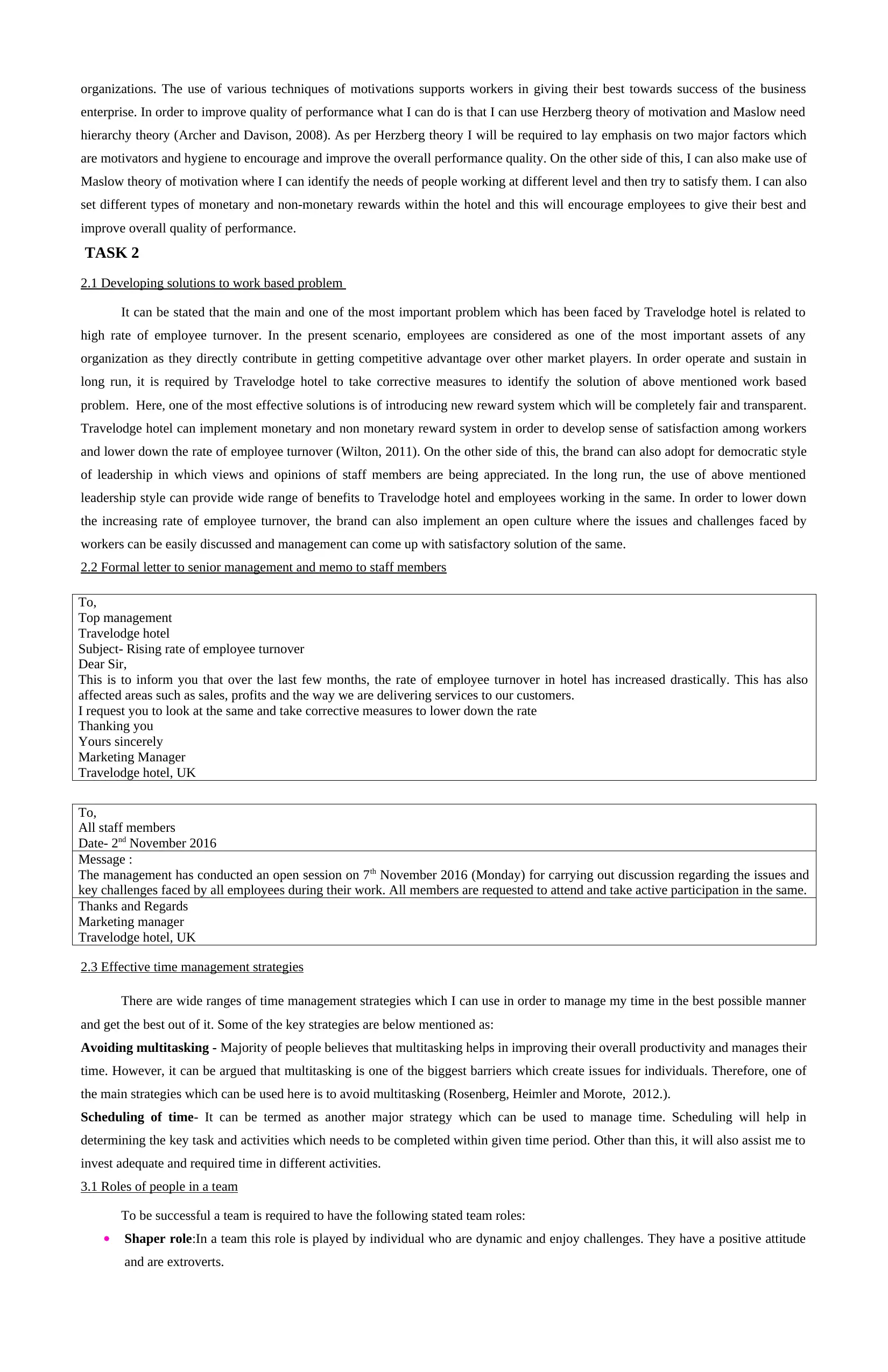
organizations. The use of various techniques of motivations supports workers in giving their best towards success of the business
enterprise. In order to improve quality of performance what I can do is that I can use Herzberg theory of motivation and Maslow need
hierarchy theory (Archer and Davison, 2008). As per Herzberg theory I will be required to lay emphasis on two major factors which
are motivators and hygiene to encourage and improve the overall performance quality. On the other side of this, I can also make use of
Maslow theory of motivation where I can identify the needs of people working at different level and then try to satisfy them. I can also
set different types of monetary and non-monetary rewards within the hotel and this will encourage employees to give their best and
improve overall quality of performance.
TASK 2
2.1 Developing solutions to work based problem
It can be stated that the main and one of the most important problem which has been faced by Travelodge hotel is related to
high rate of employee turnover. In the present scenario, employees are considered as one of the most important assets of any
organization as they directly contribute in getting competitive advantage over other market players. In order operate and sustain in
long run, it is required by Travelodge hotel to take corrective measures to identify the solution of above mentioned work based
problem. Here, one of the most effective solutions is of introducing new reward system which will be completely fair and transparent.
Travelodge hotel can implement monetary and non monetary reward system in order to develop sense of satisfaction among workers
and lower down the rate of employee turnover (Wilton, 2011). On the other side of this, the brand can also adopt for democratic style
of leadership in which views and opinions of staff members are being appreciated. In the long run, the use of above mentioned
leadership style can provide wide range of benefits to Travelodge hotel and employees working in the same. In order to lower down
the increasing rate of employee turnover, the brand can also implement an open culture where the issues and challenges faced by
workers can be easily discussed and management can come up with satisfactory solution of the same.
2.2 Formal letter to senior management and memo to staff members
To,
Top management
Travelodge hotel
Subject- Rising rate of employee turnover
Dear Sir,
This is to inform you that over the last few months, the rate of employee turnover in hotel has increased drastically. This has also
affected areas such as sales, profits and the way we are delivering services to our customers.
I request you to look at the same and take corrective measures to lower down the rate
Thanking you
Yours sincerely
Marketing Manager
Travelodge hotel, UK
To,
All staff members
Date- 2nd November 2016
Message :
The management has conducted an open session on 7th November 2016 (Monday) for carrying out discussion regarding the issues and
key challenges faced by all employees during their work. All members are requested to attend and take active participation in the same.
Thanks and Regards
Marketing manager
Travelodge hotel, UK
2.3 Effective time management strategies
There are wide ranges of time management strategies which I can use in order to manage my time in the best possible manner
and get the best out of it. Some of the key strategies are below mentioned as:
Avoiding multitasking - Majority of people believes that multitasking helps in improving their overall productivity and manages their
time. However, it can be argued that multitasking is one of the biggest barriers which create issues for individuals. Therefore, one of
the main strategies which can be used here is to avoid multitasking (Rosenberg, Heimler and Morote, 2012.).
Scheduling of time- It can be termed as another major strategy which can be used to manage time. Scheduling will help in
determining the key task and activities which needs to be completed within given time period. Other than this, it will also assist me to
invest adequate and required time in different activities.
3.1 Roles of people in a team
To be successful a team is required to have the following stated team roles:
Shaper role:In a team this role is played by individual who are dynamic and enjoy challenges. They have a positive attitude
and are extroverts.
enterprise. In order to improve quality of performance what I can do is that I can use Herzberg theory of motivation and Maslow need
hierarchy theory (Archer and Davison, 2008). As per Herzberg theory I will be required to lay emphasis on two major factors which
are motivators and hygiene to encourage and improve the overall performance quality. On the other side of this, I can also make use of
Maslow theory of motivation where I can identify the needs of people working at different level and then try to satisfy them. I can also
set different types of monetary and non-monetary rewards within the hotel and this will encourage employees to give their best and
improve overall quality of performance.
TASK 2
2.1 Developing solutions to work based problem
It can be stated that the main and one of the most important problem which has been faced by Travelodge hotel is related to
high rate of employee turnover. In the present scenario, employees are considered as one of the most important assets of any
organization as they directly contribute in getting competitive advantage over other market players. In order operate and sustain in
long run, it is required by Travelodge hotel to take corrective measures to identify the solution of above mentioned work based
problem. Here, one of the most effective solutions is of introducing new reward system which will be completely fair and transparent.
Travelodge hotel can implement monetary and non monetary reward system in order to develop sense of satisfaction among workers
and lower down the rate of employee turnover (Wilton, 2011). On the other side of this, the brand can also adopt for democratic style
of leadership in which views and opinions of staff members are being appreciated. In the long run, the use of above mentioned
leadership style can provide wide range of benefits to Travelodge hotel and employees working in the same. In order to lower down
the increasing rate of employee turnover, the brand can also implement an open culture where the issues and challenges faced by
workers can be easily discussed and management can come up with satisfactory solution of the same.
2.2 Formal letter to senior management and memo to staff members
To,
Top management
Travelodge hotel
Subject- Rising rate of employee turnover
Dear Sir,
This is to inform you that over the last few months, the rate of employee turnover in hotel has increased drastically. This has also
affected areas such as sales, profits and the way we are delivering services to our customers.
I request you to look at the same and take corrective measures to lower down the rate
Thanking you
Yours sincerely
Marketing Manager
Travelodge hotel, UK
To,
All staff members
Date- 2nd November 2016
Message :
The management has conducted an open session on 7th November 2016 (Monday) for carrying out discussion regarding the issues and
key challenges faced by all employees during their work. All members are requested to attend and take active participation in the same.
Thanks and Regards
Marketing manager
Travelodge hotel, UK
2.3 Effective time management strategies
There are wide ranges of time management strategies which I can use in order to manage my time in the best possible manner
and get the best out of it. Some of the key strategies are below mentioned as:
Avoiding multitasking - Majority of people believes that multitasking helps in improving their overall productivity and manages their
time. However, it can be argued that multitasking is one of the biggest barriers which create issues for individuals. Therefore, one of
the main strategies which can be used here is to avoid multitasking (Rosenberg, Heimler and Morote, 2012.).
Scheduling of time- It can be termed as another major strategy which can be used to manage time. Scheduling will help in
determining the key task and activities which needs to be completed within given time period. Other than this, it will also assist me to
invest adequate and required time in different activities.
3.1 Roles of people in a team
To be successful a team is required to have the following stated team roles:
Shaper role:In a team this role is played by individual who are dynamic and enjoy challenges. They have a positive attitude
and are extroverts.
Paraphrase This Document
Need a fresh take? Get an instant paraphrase of this document with our AI Paraphraser
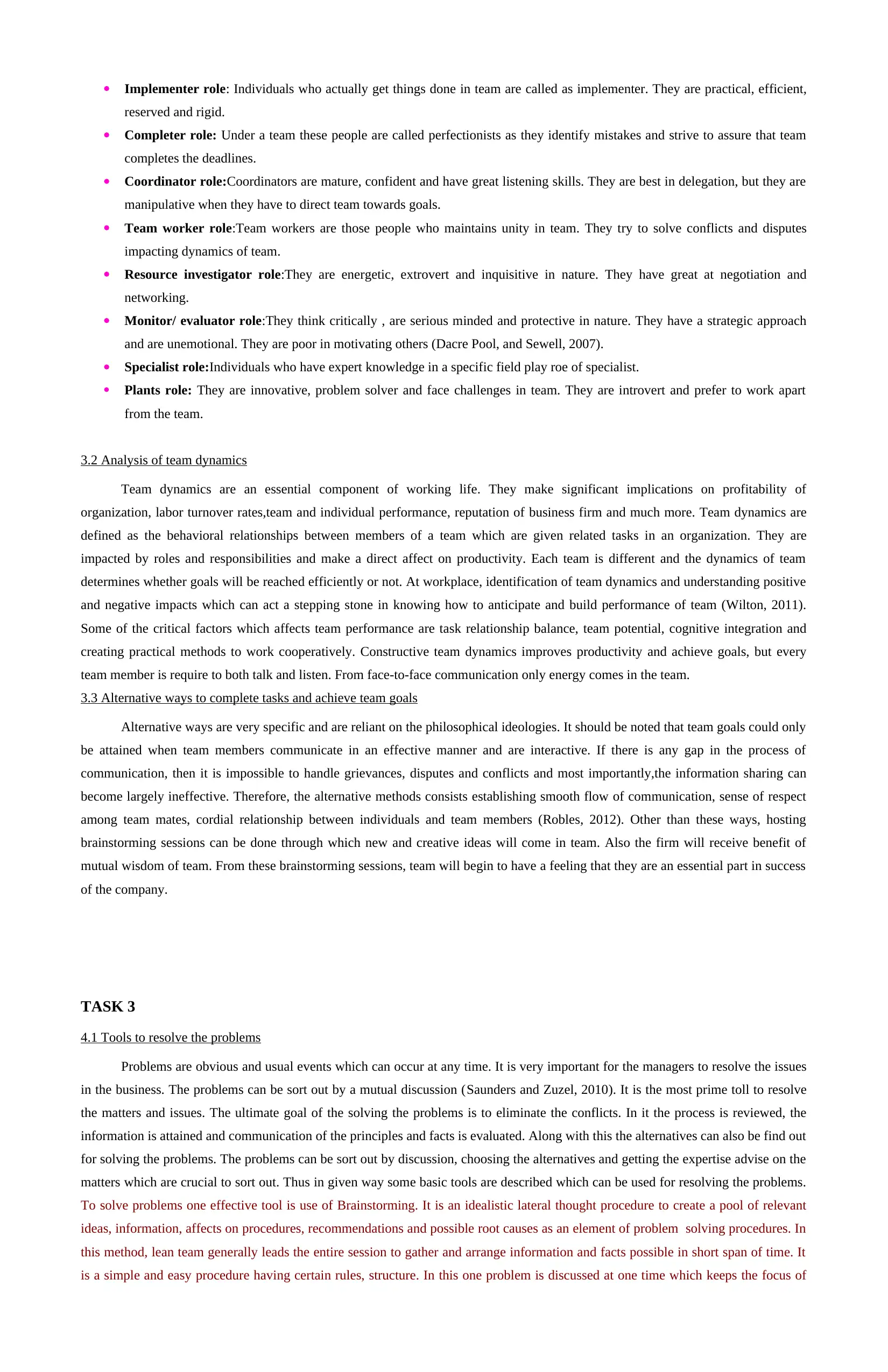
Implementer role: Individuals who actually get things done in team are called as implementer. They are practical, efficient,
reserved and rigid.
Completer role: Under a team these people are called perfectionists as they identify mistakes and strive to assure that team
completes the deadlines.
Coordinator role:Coordinators are mature, confident and have great listening skills. They are best in delegation, but they are
manipulative when they have to direct team towards goals.
Team worker role:Team workers are those people who maintains unity in team. They try to solve conflicts and disputes
impacting dynamics of team.
Resource investigator role:They are energetic, extrovert and inquisitive in nature. They have great at negotiation and
networking.
Monitor/ evaluator role:They think critically , are serious minded and protective in nature. They have a strategic approach
and are unemotional. They are poor in motivating others (Dacre Pool, and Sewell, 2007).
Specialist role:Individuals who have expert knowledge in a specific field play roe of specialist.
Plants role: They are innovative, problem solver and face challenges in team. They are introvert and prefer to work apart
from the team.
3.2 Analysis of team dynamics
Team dynamics are an essential component of working life. They make significant implications on profitability of
organization, labor turnover rates,team and individual performance, reputation of business firm and much more. Team dynamics are
defined as the behavioral relationships between members of a team which are given related tasks in an organization. They are
impacted by roles and responsibilities and make a direct affect on productivity. Each team is different and the dynamics of team
determines whether goals will be reached efficiently or not. At workplace, identification of team dynamics and understanding positive
and negative impacts which can act a stepping stone in knowing how to anticipate and build performance of team (Wilton, 2011).
Some of the critical factors which affects team performance are task relationship balance, team potential, cognitive integration and
creating practical methods to work cooperatively. Constructive team dynamics improves productivity and achieve goals, but every
team member is require to both talk and listen. From face-to-face communication only energy comes in the team.
3.3 Alternative ways to complete tasks and achieve team goals
Alternative ways are very specific and are reliant on the philosophical ideologies. It should be noted that team goals could only
be attained when team members communicate in an effective manner and are interactive. If there is any gap in the process of
communication, then it is impossible to handle grievances, disputes and conflicts and most importantly,the information sharing can
become largely ineffective. Therefore, the alternative methods consists establishing smooth flow of communication, sense of respect
among team mates, cordial relationship between individuals and team members (Robles, 2012). Other than these ways, hosting
brainstorming sessions can be done through which new and creative ideas will come in team. Also the firm will receive benefit of
mutual wisdom of team. From these brainstorming sessions, team will begin to have a feeling that they are an essential part in success
of the company.
TASK 3
4.1 Tools to resolve the problems
Problems are obvious and usual events which can occur at any time. It is very important for the managers to resolve the issues
in the business. The problems can be sort out by a mutual discussion (Saunders and Zuzel, 2010). It is the most prime toll to resolve
the matters and issues. The ultimate goal of the solving the problems is to eliminate the conflicts. In it the process is reviewed, the
information is attained and communication of the principles and facts is evaluated. Along with this the alternatives can also be find out
for solving the problems. The problems can be sort out by discussion, choosing the alternatives and getting the expertise advise on the
matters which are crucial to sort out. Thus in given way some basic tools are described which can be used for resolving the problems.
To solve problems one effective tool is use of Brainstorming. It is an idealistic lateral thought procedure to create a pool of relevant
ideas, information, affects on procedures, recommendations and possible root causes as an element of problem solving procedures. In
this method, lean team generally leads the entire session to gather and arrange information and facts possible in short span of time. It
is a simple and easy procedure having certain rules, structure. In this one problem is discussed at one time which keeps the focus of
reserved and rigid.
Completer role: Under a team these people are called perfectionists as they identify mistakes and strive to assure that team
completes the deadlines.
Coordinator role:Coordinators are mature, confident and have great listening skills. They are best in delegation, but they are
manipulative when they have to direct team towards goals.
Team worker role:Team workers are those people who maintains unity in team. They try to solve conflicts and disputes
impacting dynamics of team.
Resource investigator role:They are energetic, extrovert and inquisitive in nature. They have great at negotiation and
networking.
Monitor/ evaluator role:They think critically , are serious minded and protective in nature. They have a strategic approach
and are unemotional. They are poor in motivating others (Dacre Pool, and Sewell, 2007).
Specialist role:Individuals who have expert knowledge in a specific field play roe of specialist.
Plants role: They are innovative, problem solver and face challenges in team. They are introvert and prefer to work apart
from the team.
3.2 Analysis of team dynamics
Team dynamics are an essential component of working life. They make significant implications on profitability of
organization, labor turnover rates,team and individual performance, reputation of business firm and much more. Team dynamics are
defined as the behavioral relationships between members of a team which are given related tasks in an organization. They are
impacted by roles and responsibilities and make a direct affect on productivity. Each team is different and the dynamics of team
determines whether goals will be reached efficiently or not. At workplace, identification of team dynamics and understanding positive
and negative impacts which can act a stepping stone in knowing how to anticipate and build performance of team (Wilton, 2011).
Some of the critical factors which affects team performance are task relationship balance, team potential, cognitive integration and
creating practical methods to work cooperatively. Constructive team dynamics improves productivity and achieve goals, but every
team member is require to both talk and listen. From face-to-face communication only energy comes in the team.
3.3 Alternative ways to complete tasks and achieve team goals
Alternative ways are very specific and are reliant on the philosophical ideologies. It should be noted that team goals could only
be attained when team members communicate in an effective manner and are interactive. If there is any gap in the process of
communication, then it is impossible to handle grievances, disputes and conflicts and most importantly,the information sharing can
become largely ineffective. Therefore, the alternative methods consists establishing smooth flow of communication, sense of respect
among team mates, cordial relationship between individuals and team members (Robles, 2012). Other than these ways, hosting
brainstorming sessions can be done through which new and creative ideas will come in team. Also the firm will receive benefit of
mutual wisdom of team. From these brainstorming sessions, team will begin to have a feeling that they are an essential part in success
of the company.
TASK 3
4.1 Tools to resolve the problems
Problems are obvious and usual events which can occur at any time. It is very important for the managers to resolve the issues
in the business. The problems can be sort out by a mutual discussion (Saunders and Zuzel, 2010). It is the most prime toll to resolve
the matters and issues. The ultimate goal of the solving the problems is to eliminate the conflicts. In it the process is reviewed, the
information is attained and communication of the principles and facts is evaluated. Along with this the alternatives can also be find out
for solving the problems. The problems can be sort out by discussion, choosing the alternatives and getting the expertise advise on the
matters which are crucial to sort out. Thus in given way some basic tools are described which can be used for resolving the problems.
To solve problems one effective tool is use of Brainstorming. It is an idealistic lateral thought procedure to create a pool of relevant
ideas, information, affects on procedures, recommendations and possible root causes as an element of problem solving procedures. In
this method, lean team generally leads the entire session to gather and arrange information and facts possible in short span of time. It
is a simple and easy procedure having certain rules, structure. In this one problem is discussed at one time which keeps the focus of
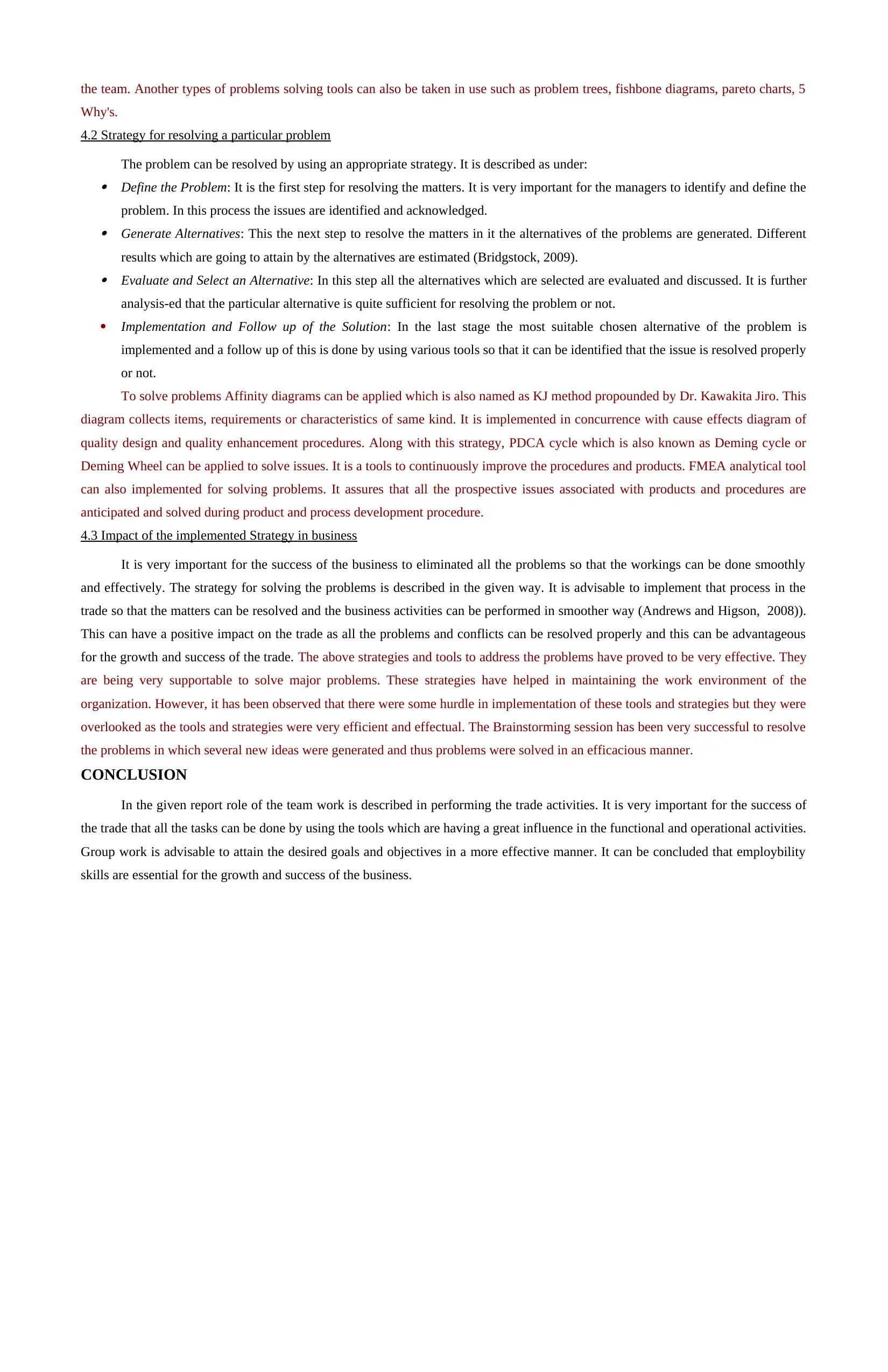
the team. Another types of problems solving tools can also be taken in use such as problem trees, fishbone diagrams, pareto charts, 5
Why's.
4.2 Strategy for resolving a particular problem
The problem can be resolved by using an appropriate strategy. It is described as under: Define the Problem: It is the first step for resolving the matters. It is very important for the managers to identify and define the
problem. In this process the issues are identified and acknowledged. Generate Alternatives: This the next step to resolve the matters in it the alternatives of the problems are generated. Different
results which are going to attain by the alternatives are estimated (Bridgstock, 2009). Evaluate and Select an Alternative: In this step all the alternatives which are selected are evaluated and discussed. It is further
analysis-ed that the particular alternative is quite sufficient for resolving the problem or not.
Implementation and Follow up of the Solution: In the last stage the most suitable chosen alternative of the problem is
implemented and a follow up of this is done by using various tools so that it can be identified that the issue is resolved properly
or not.
To solve problems Affinity diagrams can be applied which is also named as KJ method propounded by Dr. Kawakita Jiro. This
diagram collects items, requirements or characteristics of same kind. It is implemented in concurrence with cause effects diagram of
quality design and quality enhancement procedures. Along with this strategy, PDCA cycle which is also known as Deming cycle or
Deming Wheel can be applied to solve issues. It is a tools to continuously improve the procedures and products. FMEA analytical tool
can also implemented for solving problems. It assures that all the prospective issues associated with products and procedures are
anticipated and solved during product and process development procedure.
4.3 Impact of the implemented Strategy in business
It is very important for the success of the business to eliminated all the problems so that the workings can be done smoothly
and effectively. The strategy for solving the problems is described in the given way. It is advisable to implement that process in the
trade so that the matters can be resolved and the business activities can be performed in smoother way (Andrews and Higson, 2008)).
This can have a positive impact on the trade as all the problems and conflicts can be resolved properly and this can be advantageous
for the growth and success of the trade. The above strategies and tools to address the problems have proved to be very effective. They
are being very supportable to solve major problems. These strategies have helped in maintaining the work environment of the
organization. However, it has been observed that there were some hurdle in implementation of these tools and strategies but they were
overlooked as the tools and strategies were very efficient and effectual. The Brainstorming session has been very successful to resolve
the problems in which several new ideas were generated and thus problems were solved in an efficacious manner.
CONCLUSION
In the given report role of the team work is described in performing the trade activities. It is very important for the success of
the trade that all the tasks can be done by using the tools which are having a great influence in the functional and operational activities.
Group work is advisable to attain the desired goals and objectives in a more effective manner. It can be concluded that employbility
skills are essential for the growth and success of the business.
Why's.
4.2 Strategy for resolving a particular problem
The problem can be resolved by using an appropriate strategy. It is described as under: Define the Problem: It is the first step for resolving the matters. It is very important for the managers to identify and define the
problem. In this process the issues are identified and acknowledged. Generate Alternatives: This the next step to resolve the matters in it the alternatives of the problems are generated. Different
results which are going to attain by the alternatives are estimated (Bridgstock, 2009). Evaluate and Select an Alternative: In this step all the alternatives which are selected are evaluated and discussed. It is further
analysis-ed that the particular alternative is quite sufficient for resolving the problem or not.
Implementation and Follow up of the Solution: In the last stage the most suitable chosen alternative of the problem is
implemented and a follow up of this is done by using various tools so that it can be identified that the issue is resolved properly
or not.
To solve problems Affinity diagrams can be applied which is also named as KJ method propounded by Dr. Kawakita Jiro. This
diagram collects items, requirements or characteristics of same kind. It is implemented in concurrence with cause effects diagram of
quality design and quality enhancement procedures. Along with this strategy, PDCA cycle which is also known as Deming cycle or
Deming Wheel can be applied to solve issues. It is a tools to continuously improve the procedures and products. FMEA analytical tool
can also implemented for solving problems. It assures that all the prospective issues associated with products and procedures are
anticipated and solved during product and process development procedure.
4.3 Impact of the implemented Strategy in business
It is very important for the success of the business to eliminated all the problems so that the workings can be done smoothly
and effectively. The strategy for solving the problems is described in the given way. It is advisable to implement that process in the
trade so that the matters can be resolved and the business activities can be performed in smoother way (Andrews and Higson, 2008)).
This can have a positive impact on the trade as all the problems and conflicts can be resolved properly and this can be advantageous
for the growth and success of the trade. The above strategies and tools to address the problems have proved to be very effective. They
are being very supportable to solve major problems. These strategies have helped in maintaining the work environment of the
organization. However, it has been observed that there were some hurdle in implementation of these tools and strategies but they were
overlooked as the tools and strategies were very efficient and effectual. The Brainstorming session has been very successful to resolve
the problems in which several new ideas were generated and thus problems were solved in an efficacious manner.
CONCLUSION
In the given report role of the team work is described in performing the trade activities. It is very important for the success of
the trade that all the tasks can be done by using the tools which are having a great influence in the functional and operational activities.
Group work is advisable to attain the desired goals and objectives in a more effective manner. It can be concluded that employbility
skills are essential for the growth and success of the business.
⊘ This is a preview!⊘
Do you want full access?
Subscribe today to unlock all pages.

Trusted by 1+ million students worldwide
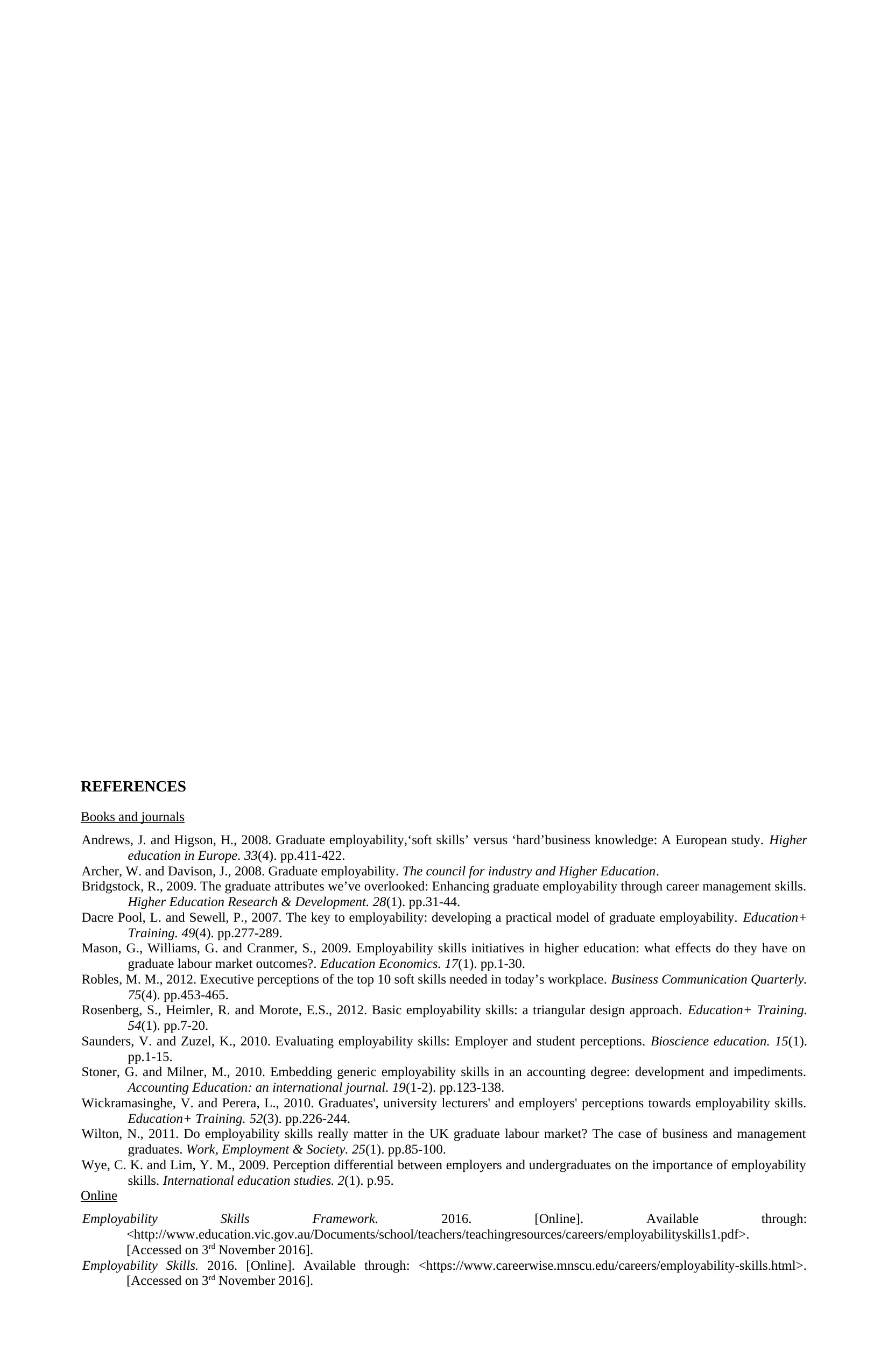
REFERENCES
Books and journals
Andrews, J. and Higson, H., 2008. Graduate employability,‘soft skills’ versus ‘hard’business knowledge: A European study. Higher
education in Europe. 33(4). pp.411-422.
Archer, W. and Davison, J., 2008. Graduate employability. The council for industry and Higher Education.
Bridgstock, R., 2009. The graduate attributes we’ve overlooked: Enhancing graduate employability through career management skills.
Higher Education Research & Development. 28(1). pp.31-44.
Dacre Pool, L. and Sewell, P., 2007. The key to employability: developing a practical model of graduate employability. Education+
Training. 49(4). pp.277-289.
Mason, G., Williams, G. and Cranmer, S., 2009. Employability skills initiatives in higher education: what effects do they have on
graduate labour market outcomes?. Education Economics. 17(1). pp.1-30.
Robles, M. M., 2012. Executive perceptions of the top 10 soft skills needed in today’s workplace. Business Communication Quarterly.
75(4). pp.453-465.
Rosenberg, S., Heimler, R. and Morote, E.S., 2012. Basic employability skills: a triangular design approach. Education+ Training.
54(1). pp.7-20.
Saunders, V. and Zuzel, K., 2010. Evaluating employability skills: Employer and student perceptions. Bioscience education. 15(1).
pp.1-15.
Stoner, G. and Milner, M., 2010. Embedding generic employability skills in an accounting degree: development and impediments.
Accounting Education: an international journal. 19(1-2). pp.123-138.
Wickramasinghe, V. and Perera, L., 2010. Graduates', university lecturers' and employers' perceptions towards employability skills.
Education+ Training. 52(3). pp.226-244.
Wilton, N., 2011. Do employability skills really matter in the UK graduate labour market? The case of business and management
graduates. Work, Employment & Society. 25(1). pp.85-100.
Wye, C. K. and Lim, Y. M., 2009. Perception differential between employers and undergraduates on the importance of employability
skills. International education studies. 2(1). p.95.
Online
Employability Skills Framework. 2016. [Online]. Available through:
<http://www.education.vic.gov.au/Documents/school/teachers/teachingresources/careers/employabilityskills1.pdf>.
[Accessed on 3rd November 2016].
Employability Skills. 2016. [Online]. Available through: <https://www.careerwise.mnscu.edu/careers/employability-skills.html>.
[Accessed on 3rd November 2016].
Books and journals
Andrews, J. and Higson, H., 2008. Graduate employability,‘soft skills’ versus ‘hard’business knowledge: A European study. Higher
education in Europe. 33(4). pp.411-422.
Archer, W. and Davison, J., 2008. Graduate employability. The council for industry and Higher Education.
Bridgstock, R., 2009. The graduate attributes we’ve overlooked: Enhancing graduate employability through career management skills.
Higher Education Research & Development. 28(1). pp.31-44.
Dacre Pool, L. and Sewell, P., 2007. The key to employability: developing a practical model of graduate employability. Education+
Training. 49(4). pp.277-289.
Mason, G., Williams, G. and Cranmer, S., 2009. Employability skills initiatives in higher education: what effects do they have on
graduate labour market outcomes?. Education Economics. 17(1). pp.1-30.
Robles, M. M., 2012. Executive perceptions of the top 10 soft skills needed in today’s workplace. Business Communication Quarterly.
75(4). pp.453-465.
Rosenberg, S., Heimler, R. and Morote, E.S., 2012. Basic employability skills: a triangular design approach. Education+ Training.
54(1). pp.7-20.
Saunders, V. and Zuzel, K., 2010. Evaluating employability skills: Employer and student perceptions. Bioscience education. 15(1).
pp.1-15.
Stoner, G. and Milner, M., 2010. Embedding generic employability skills in an accounting degree: development and impediments.
Accounting Education: an international journal. 19(1-2). pp.123-138.
Wickramasinghe, V. and Perera, L., 2010. Graduates', university lecturers' and employers' perceptions towards employability skills.
Education+ Training. 52(3). pp.226-244.
Wilton, N., 2011. Do employability skills really matter in the UK graduate labour market? The case of business and management
graduates. Work, Employment & Society. 25(1). pp.85-100.
Wye, C. K. and Lim, Y. M., 2009. Perception differential between employers and undergraduates on the importance of employability
skills. International education studies. 2(1). p.95.
Online
Employability Skills Framework. 2016. [Online]. Available through:
<http://www.education.vic.gov.au/Documents/school/teachers/teachingresources/careers/employabilityskills1.pdf>.
[Accessed on 3rd November 2016].
Employability Skills. 2016. [Online]. Available through: <https://www.careerwise.mnscu.edu/careers/employability-skills.html>.
[Accessed on 3rd November 2016].
Paraphrase This Document
Need a fresh take? Get an instant paraphrase of this document with our AI Paraphraser

What are the top ten skills that employers want?. 2016. [Online]. Available through: <https://www.kent.ac.uk/careers/sk/top-ten-
skills.htm>. [Accessed on 3rd November 2016].
skills.htm>. [Accessed on 3rd November 2016].
1 out of 8
Related Documents
Your All-in-One AI-Powered Toolkit for Academic Success.
+13062052269
info@desklib.com
Available 24*7 on WhatsApp / Email
![[object Object]](/_next/static/media/star-bottom.7253800d.svg)
Unlock your academic potential
Copyright © 2020–2025 A2Z Services. All Rights Reserved. Developed and managed by ZUCOL.



